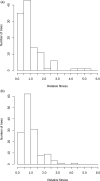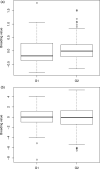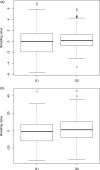How does contemporary selection shape oak phenotypes?
- PMID: 33294022
- PMCID: PMC7691464
- DOI: 10.1111/eva.13082
How does contemporary selection shape oak phenotypes?
Abstract
Most existing forests are subjected to natural and human-mediated selection pressures, which have increased due to climate change and the increasing needs of human societies for wood, fibre and fuel resources. It remains largely unknown how these pressures trigger evolutionary changes. We address this issue here for temperate European oaks (Quercus petraea and Q. robur), which grow in mixed stands, under even-aged management regimes. We screened numerous functional traits for univariate selection gradients and for expected and observed genetic changes over two successive generations. In both species, growth, leaf morphology and physiology, and defence-related traits displayed significant selection gradients and predicted shifts, whereas phenology, water metabolism, structure and resilience-related traits did not. However, the direction of the selection response and the potential for adaptive evolution differed between the two species. Quercus petraea had a much larger phenotypic and genetic variance of fitness than Q. robur. This difference raises concerns about the adaptive response of Q. robur to contemporary selection pressures. Our investigations suggest that Q. robur will probably decline steadily, particularly in mixed stands with Q. petraea, consistent with the contrasting demographic dynamics of the two species.
Keywords: Quercus petraea; Quercus robur; fitness; second theorem of selection; selection gradients.
© 2020 The Authors. Evolutionary Applications published by John Wiley & Sons Ltd.
Figures



References
-
- Alberto, F. , Bouffier, L. , Louvet, J. M. , Lamy, J. B. , Delzon, S. , & Kremer, A. (2011). Adaptive responses for seed and leaf phenology in natural populations of sessile oak along an altitudinal gradient. Journal of Evolutionary Biology, 24(7), 1442–1454. 10.1111/j.1420-9101.2011.02277.x - DOI - PubMed
-
- Alexandre, H. , Truffaut, L. , Ducousso, A. , Louvet, J. M. , Nepveu, G. , Torres‐Ruiz, J. M. , … Kremer, A. (2020). In situ estimation of genetic variation of functional and ecological traits in Q. petraea and Q. robur . Trees Genetics and Genomes, 16, 32 10.1007/s11295-019-1407-9 - DOI - PMC - PubMed
Grants and funding
LinkOut - more resources
Full Text Sources

